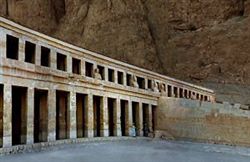
Place on the west bank of the Nile at Luxor. Here, tucked against the cliff face, are a number of temples. The oldest belongs to Nebhepetre Montuhotep II (11th Dynasty), constructed as a terraced temple in imitation of the primeval hill. The rearmost part of the temple is built above the royal tomb. The temple also contains the burial shafts of six queens and priestesses of Hathor. The temple of Hatshepsut is the best preserved temple at Deir el-Bahari. It, too, has several columned terraces. Much of the architecture and details are inspired by the temple of Montuhotep alongside. Among the decoration of the temple are scenes of the birth of Hatshepsut, emphasizing her divine ancestry, representations of the transport of obelisks intended for the temple of Karnak, and an account of an expedition to the land of Punt. Underneath the courtyard of the temple is the tomb of Senenmut, a favourite of Hatshepsut. In Ptolemaic times the temple became a place of pilgrimage for the sick. A chapel dedicated to Asklepios, the Greek god of healing, was built by Ptolemy III, and shortly afterwards there was also a chapel for various other healing gods, including Imhotep and Amenhotep son of Hapu. The temple of Tuthmosis III is probably not meant to be a mortuary temple for that king but a new sanctuary for those gods whose chapels had been damaged by his attempts to eradicate the memory of Hatshepsut. In addition to these temples, there are also remains of other sanctuaries at Deir el-Bahari. Further, there are also the tombs of many officials, not only from the reigns of the kings in question but also from the Late Period. The so-called cachettes in particular must be mentioned here, communal tombs into which the mummies of kings from earlier times were reburied together in the 21st Dynasty, sometimes together with members of their families, after their own tombs had been plundered. Priestly families from the 21st and 22nd Dynasties were also buried in cachettes in the area.